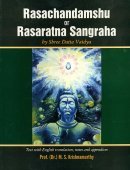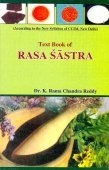Gajaputa, Gaja-puta, Gajapuṭa: 10 definitions
Introduction:
Gajaputa means something in Hinduism, Sanskrit, Marathi. If you want to know the exact meaning, history, etymology or English translation of this term then check out the descriptions on this page. Add your comment or reference to a book if you want to contribute to this summary article.
In Hinduism
Ayurveda (science of life)
Rasashastra (Alchemy and Herbo-Mineral preparations)
Source: archive.org: Rasa-Jala-Nidhi: Or Ocean of indian chemistry and alchemyGajapuṭa (गजपुट).—A cubical pit, one gaja in length, breadth, and height, each, is to be filled up with cowdung cakes up to the brim. A crucible, containing the prescribed material, is to be placed upon the heap of cowdung cakes. Half the number of the cakes, required for filling up the pit, are now to be placed upon the heap, which is next to be set fire to. Burning a metal in this way is called, burning by “Gajaputa.” A “gaja” is equaivalent to 30 angulis of an ordinary human being. Burning in this way increases the potency of mercury to a great extent. (see Bhudeb Mookerji and his Rasajalanidhi)
Source: Academia.edu: Ayurveda and Pharmaceutics (rasashastra)The Gajapuṭa is an arrangement of heating in a pit of 90 cm in length, breadth and depth. Half the pit is filled with cow-dung cakes.

Āyurveda (आयुर्वेद, ayurveda) is a branch of Indian science dealing with medicine, herbalism, taxology, anatomy, surgery, alchemy and related topics. Traditional practice of Āyurveda in ancient India dates back to at least the first millenium BC. Literature is commonly written in Sanskrit using various poetic metres.
Languages of India and abroad
Marathi-English dictionary
Source: DDSA: The Molesworth Marathi and English Dictionarygajapūṭa (गजपूट) [or ठ, ṭha].—n A method of preparing medicaments. In a cubical pit of one gaja the herbs, roots, drugs, with goat's dung, charcoal &c. are arranged, and according to the directions of the vaidyaśāstra are calcined, burned, heated &c. v dē, kara.
Marathi is an Indo-European language having over 70 million native speakers people in (predominantly) Maharashtra India. Marathi, like many other Indo-Aryan languages, evolved from early forms of Prakrit, which itself is a subset of Sanskrit, one of the most ancient languages of the world.
Sanskrit dictionary
Source: DDSA: The practical Sanskrit-English dictionaryGajapuṭa (गजपुट).—a small hole in the ground for fire.
Derivable forms: gajapuṭaḥ (गजपुटः).
Gajapuṭa is a Sanskrit compound consisting of the terms gaja and puṭa (पुट).
Source: Cologne Digital Sanskrit Dictionaries: Shabda-Sagara Sanskrit-English DictionaryGajapuṭa (गजपुट).—m.
(-ṭaḥ) A small hollow for a fire, over which to prepare medical decoctions, extracts, &c. E. gaja, and puṭa a hollow.
Source: Cologne Digital Sanskrit Dictionaries: Monier-Williams Sanskrit-English DictionaryGajapuṭa (गजपुट):—[=gaja-puṭa] [from gaja > gaj] m. a small hole in the ground for a fire (over which to prepare food or medicine), [Bhāvaprakāśa]
Source: Cologne Digital Sanskrit Dictionaries: Yates Sanskrit-English DictionaryGajapuṭa (गजपुट):—[gaja-puṭa] (ṭaḥ) 1. m. Hollow for a fire to prepare decoctions.
[Sanskrit to German]
Sanskrit, also spelled संस्कृतम् (saṃskṛtam), is an ancient language of India commonly seen as the grandmother of the Indo-European language family (even English!). Closely allied with Prakrit and Pali, Sanskrit is more exhaustive in both grammar and terms and has the most extensive collection of literature in the world, greatly surpassing its sister-languages Greek and Latin.
Kannada-English dictionary
Source: Alar: Kannada-English corpusGajapuṭa (ಗಜಪುಟ):—
1) [noun] a hollow or depression made in the ground for fire.
2) [noun] the act or process of cooking, boiling on such a fire; a heating intensely.
Kannada is a Dravidian language (as opposed to the Indo-European language family) mainly spoken in the southwestern region of India.
See also (Relevant definitions)
Full-text: Gajaputi, Ardhobhakaputa.
Relevant text
Search found 5 books and stories containing Gajaputa, Gaja-puta, Gaja-puṭa, Gajapuṭa, Gajapūṭa; (plurals include: Gajaputas, putas, puṭas, Gajapuṭas, Gajapūṭas). You can also click to the full overview containing English textual excerpts. Below are direct links for the most relevant articles:
Rasa Jala Nidhi, vol 2: Minerals (uparasa) (by Bhudeb Mookerjee)
Part 4 - Process for creation of Dhanya-abhra (paddy mica) < [Chapter I - Uparasa (1): Abhra or Abhraka (mica)]
Part 6 - Incineration of the essence of tuttha and that of sasyaka < [Chapter V - Uparasa (5-6): Tuttha and Sasyaka (copper sulphate)]
Part 3 - Incineration of bimala < [Chapter III - Uparasa (3): Bimala or Vimala (pyrites with red tints)]
Rasa Jala Nidhi, vol 1: Initiation, Mercury and Laboratory (by Bhudeb Mookerjee)
Part 3 - Burning pits (puta or samputa) < [Chapter VI - Laboratory equipment]
Part 18 - Mercurial operations (16): Incineration of mercury (bhasmikarana) < [Chapter IV-V - Mercurial operations]
Rasa Jala Nidhi, vol 3: Metals, Gems and other substances (by Bhudeb Mookerjee)
Part 3 - Incineration of gold < [Chapter I - Metals (1): Suvarna (Gold)]
Part 9 - Softening of Diamonds < [Chapter XIII - Gems (1): Vajra or Hiraka (diamond)]
Part 3 - Incineration of copper < [Chapter III - Metals (3): Tamra (copper)]
Rasa Jala Nidhi, vol 4: Iatrochemistry (by Bhudeb Mookerjee)
Part 17 - Treatment for enlargement of spleen and liver (16): Rasapati rasa < [Chapter VII - Enlargement of spleen (plihodara) and liver (yakridudara)]
Part 10 - Treatment for enlargement of spleen and liver (9): Lokanatha rasa < [Chapter VII - Enlargement of spleen (plihodara) and liver (yakridudara)]
Part 58 - Treatment for chronic diarrhea (30): Vahni-dipana rasa < [Chapter III - Jvaratisara fever with diarrhoea]
Rasa Jala Nidhi, vol 5: Treatment of various afflictions (by Bhudeb Mookerjee)
Related products

